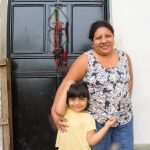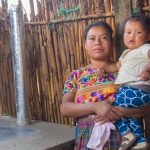Smokeless Stoves: Matea Chiroy Chuj de Mendoza and Susana Xoquic Guit

Matea Chiroy Chuj
A green basket of fresh tortillas sits on the ledge of Matea Chiroy Chuj de Mendoza’s smokeless stove. Steam rises from the hot stack, fresh from the grill. Matea adds to the pile, working each mass of corn flour against the palms of her hands before flipping them down on the metal surface. Her husband, Tomás, sits and looks on.
“I like how there is more space to cook everything here; beans, tortillas, tamales, all at the same time,” Matea (47) comments. “A complete meal can be prepared like this.”
As she continues to make tortillas, Matea speaks in Kaqchikel, a Maya dialect, about how she is still getting used to a good stovetop. “For my whole life, I cooked in the ground,” she reflects. “There was another grill given to us by an NGO, which we used for about two years. But it didn’t work very well.”

Matea also found herself frustrated, particularly with how terribly her health fared. “The smoke affected me. Mostly my lungs. I didn’t go to the doctor because I could not afford the medicine there. It was so much money, 150 Quetzales ($20) and it wasn’t worth it.” She also laments about wasting wood. “My husband and I used to go out every day to find wood. It took so much time in a place where there aren’t a lot of resources.”
One day, however, her life changed for the better. “There was a leader in our community that put us in contact with Habitat Guatemala,” she remembers. “The organization has worked here before. We had seen groups of volunteers in the community, building stoves and such, and we thought that was a service that we needed.”

Using a machine, Matea and her husband spent two days cutting blocks for the stove. It only took them two days to finish. Then, a group of volunteers arrived. Matea’s eyes light up when we mention them. “I remember how the team came in two buses. They did a great job, and Don Efraim, our mason, was also so hardworking.” She smiles. “It was a beautiful experience. We are very grateful and happy. This is a better way to help our family.”
For the past nine months, Matea has enjoyed the use of her stove. She is excited that the days of cooking in the ground are far behind her and that she, her husband, and their children may enjoy the path to a safer, healthier life.
Susana Xoquic Guit
A Habitat Guatemala smokeless stove sits quietly in the middle of Susana Xoquic Guit’s kitchen. On top of its surface, pots simmer with the midday meal. The fire below gives off a warm glow, and an occasional crackling snaps through the air. The scene is peaceful. However, Susana reveals that this way of cooking is relatively new for her.
“Our old stove was pieces of blocks that were stacked on the ground. It was tiny, fitting into a corner,” she says in Kaqchikel, a local Maya dialect. “It wasn’t reliable. The smoke always leaked out of it, and cooking took so much time.”
Susana suffered for her efforts to prepare meals for her family of seven. “When there was smoke filling the room, I was always with a cough or a cold,” she says. “I bought some medicines from the health clinic, but it was so far and out of my way.” As for her children, Susana worried for their safety. “My children burned themselves all the time on the logs that would fall out of the stove.”

One day, Susana saw a stove building project taking place in her community of Caserio Vasconcelos. Curious, she decided to investigate. “We asked if these were projects for people like us.” It turns out that there was a local committee visiting that day, encouraging community members to apply for a Habitat Guatemala Healthy Home Kit. The kit would include a smokeless stove for Susana and her family.
A group of volunteers similar to the ones that Susana had seen that day soon showed up at her house, eager to build. It took about six hours. “That is how the stove came to be,” Susana remarks.
The best change, Susana explains, is that the stove no longer hurts her children, but helps them. “My favorite thing about the new stove is that it’s taller, so they can’t hurt themselves.” The stove has brought several economic benefits, too. “We also save for not having to look for wood. That way, we can buy food, clothes, and school supplies for our children.”
We ask Susana to describe the group of volunteers that helped her family build her stove. She speaks with gratitude, her voice trembling. “You worked so hard. Thank you for all of your hard work. Thank you for taking the time to play with my children. We are very grateful for your support. We don’t have money or the education to build a stove on our own. I don’t have any more words to say other than thank you.”




